The Construction of Ecological Security Pattern under Rapid Urbanization in the Loess Plateau: A Case Study of Taiyuan City
Abstract
:1. Introduction
2. Materials and Methods
2.1. Study Area
2.2. Data Description
2.3. Methods
2.3.1. Analytical Steps
2.3.2. Landscape Transition Matrix
2.3.3. LULC Dynamic Degree
2.3.4. Soil Conservation Assessment
2.3.5. Habitat Quality Assessment
2.3.6. Water Yield Assessment
2.3.7. Carbon Storage Assessment
2.3.8. Extraction of Ecological Corridors
3. Results
3.1. Information Extraction from RS Data
3.2. Characteristics of Land Use Dynamic Change
3.3. Identification of Ecological Source
3.3.1. Soil Conservation, Water Yield, and Carbon Storage Assessment
3.3.2. Habitat Quality Assessment
3.3.3. Ecological Source in Taiyuan City
3.4. Construction of Resistance Surface
3.5. Identification of Ecological Corridors, Nodes, and Obstacle Points
4. Discussion
4.1. Ecological Source Assessment
4.2. Construction of Ecological Security Pattern in Taiyuan City
4.3. Limitations and Future Research Directions
5. Conclusions
- (1)
- During the period from 1980 to 2020, urban construction land has continuously increased, with a cumulative increase of 432.05 km2; cultivated land area continued to decrease, with a cumulative decrease of 344.82 km2; grassland and water area have also experienced a decrease of 146.1 km2 and 1.98 km2, respectively. Significant LULC changes occurred from 2000 to 2010, which was also a decade of rapid development.
- (2)
- The total amount of soil conservation in Taiyuan was 2.18 × 108 t. The total water yield was 6.47 × 108 m3, which is close to the annual runoff of 7.15 × 108 m3 in the Water Resources Bulletin of Taiyuan. The carbon storage ranges from 0.14 to 14.37 Mg/ha, with an average of 12.83 Mg/ha. The average habitat quality index was 0.56.
- (3)
- A total of 38 ecological sources were identified, covering an area of 1124.16 km2 and accounting for 16% of the total area of Taiyuan City. The ecological sources were mainly woodlands and grasslands. Comprehensive resistance surface analysis shows that areas with high resistance values were mainly concentrated in the central urban area of Taiyuan City and the built-up area of local counties. A total of 79 corridors and 31 ecological “pinch points” were identified in Taiyuan City, which were mainly distributed in the corridors near each ecological source. Six ecological barrier points were also identified, the largest of which was located near the northern corridor of Taiyuan City. There are significant spatial differences in ecological sources in Taiyuan, which are shown as “six districts” and Qingxu county are lower than Yangqu County, Gujiao City, and Loufan County.
- (4)
- Integrate the ecological source, corridor, pinch, and obstacle points, and bring the Fenhe River bank zone into the construction of regional ecological security patterns as an important river ecological corridor. The optimal management model of the ecological security pattern of “two rings, four regions, and nine corridors” was constructed.
Author Contributions
Funding
Data Availability Statement
Acknowledgments
Conflicts of Interest
References
- Mooney, H.A.; Duraiappah, A.; Larigauderie, A. Evolution of natural and social science interactions in global change research programs. Proc. Natl. Acad. Sci. USA 2013, 110 (Suppl. 1), 3665–3672. [Google Scholar] [CrossRef] [PubMed] [Green Version]
- Hailu, A.; Mammo, S.; Kidane, M. Dynamics of land use, land cover change trend and its drivers in Jimma Geneti District, Western Ethiopia. Land Use Policy 2020, 99, 105011. [Google Scholar] [CrossRef]
- Turner, B.L.; Moss, R.H.; Skole, D.L. Relating land use and global land cover change: A proposal for an IGBP-HDP core. Project. Report from the IGBP-HDP Working Group on Land use/land Cover Change. In Joint Publication of the IGBP No. 24 and HDP No 5; Swedish Academy of Sciences: Stockholm, Sweden, 1993. [Google Scholar]
- Gebreslassie, H. Land Use-Land Cover dynamics of Huluka watershed, central rift Valley, Ethiopia. Int. Soil Water Conserv. Res. 2014, 2, 25–33. [Google Scholar] [CrossRef] [Green Version]
- Su, S.; Xiao, R.; Jiang, Z.; Zhang, Y. Characterizing landscape pattern and ecosystem service value changes for urbanization impacts at an eco-regional scale. Appl. Geogr. 2012, 34, 295–305. [Google Scholar] [CrossRef]
- Haas, J.; Ban, Y. Urban growth and environmental impacts in Jing-Jin-Ji, the Yangtze, river delta and the Pearl River delta. Int. J. Appl. Earth Obs. Geoinf. 2014, 30, 42–55. [Google Scholar] [CrossRef]
- Li, J.; Fang, W.; Wang, T.; Qureshi, S.; Alatalo, J.; Bai, Y. Correlations between socioeconomic drivers and indicators of urban expansion: Evidence from the heavily urbanised Shanghai metropolitan area, China. Sustainability 2017, 9, 1199. [Google Scholar] [CrossRef] [Green Version]
- Wang, S.; Cao, Z.; Luo, P.; Zhu, W. Spatiotemporal variations and climatological trends in precipitation indices in Shaanxi Province, China. Atmosphere 2022, 13, 744. [Google Scholar] [CrossRef]
- Luo, P.; Mu, Y.; Wang, S.; Zhu, W.; Mishra, B.K.; Huo, A.; Zhou, M.; Lyu, J.; Hu, M.; Duan, W.; et al. Exploring sustainable solutions for the water environment in Chinese and Southeast Asian cities. Ambio 2022, 51, 1199–1218. [Google Scholar] [CrossRef] [PubMed]
- Cetin, M.; Adiguzel, F.; Gungor, S.; Kaya, E.; Sancar, M.C. Evaluation of thermal climatic region areas in terms of building density in urban management and planning for Burdur, Turkey. Air Qual. Atmos. Health 2019, 12, 1103–1112. [Google Scholar] [CrossRef]
- Willemen, L.; Barger, N.N.; ten Brink, B.T.; Cantele, M.; Erasmus, B.F.N.; Fisher, J.L.; Gardner, T.; Holland, T.G.; Kohler, F.; Kotiaho, J.S.; et al. How to halt the global decline of lands. Nat. Sustain. 2020, 3, 164–166. [Google Scholar] [CrossRef] [Green Version]
- Wu, J.; Xiang, W.-N.; Zhao, J. Urban ecology in China: Historical developments and future directions. Landsc. Urban Plan. 2014, 125, 222–233. [Google Scholar] [CrossRef]
- Norström, A.V.; Cvitanovic, C.; Löf, M.F.; West, S.; Wyborn, C.; Balvanera, P.; Bednarek, A.T.; Bennett, E.M.; Biggs, R.; de Bremond, A.; et al. Principles for knowledge co-production in sustainability research. Nat. Sustain. 2020, 3, 182–190. [Google Scholar] [CrossRef]
- Peng, J.; Pan, Y.; Liu, Y.; Zhao, H.; Wang, Y. Linking ecological degradation risk to identify ecological security patterns in a rapidly urbanizing landscape. Habitat Int. 2018, 71, 110–124. [Google Scholar] [CrossRef]
- Yang, R.; Du, W.; Yang, Z. Spatiotemporal evolution and influencing factors of urban land ecological security in Yunnan Province. Sustainability 2021, 13, 2936. [Google Scholar] [CrossRef]
- Ding, M.; Liu, W.; Xiao, L.; Zhong, F.; Lu, N.; Zhang, J.; Zhang, Z.; Xu, X.; Wang, K. Construction and optimization strategy of ecological security pattern in a rapidly urbanizing region: A case study in central-south China. Ecol. Indic. 2022, 136, 108064. [Google Scholar] [CrossRef]
- Yu, K.J. Security patterns and surface model in landscape ecological planning. Landsc. Urban Plan. 1996, 36, 1–17. [Google Scholar] [CrossRef]
- Peng, J.; Zhao, H.; Liu, Y.; Wu, J. Research progress and prospect on regional ecological security pattern construction. Geogr. Res. 2017, 36, 407–419. [Google Scholar] [CrossRef]
- Chai, J.; Wang, Z.; Yu, C. Analysis for the interaction relationship between urbanization and ecological security: A case study in wuhan city Circle of China. Int. J. Environ. Res. Public Health 2021, 18, 13187. [Google Scholar] [CrossRef]
- Wang, S.; Zhang, X.; Wu, T.; Yang, Y. The evolution of landscape ecological security in Beijing under the influence of different policies in recent decades. Sci. Total Environ. 2019, 646, 49–57. [Google Scholar] [CrossRef]
- Xu, D.; Yang, F.; Yu, L.; Zhou, Y.; Li, H.; Ma, J.; Huang, J.; Wei, J.; Xu, Y.; Zhang, C.; et al. Quantization of the coupling mechanism between eco-environmental quality and urbanization from multisource remote sensing data. J. Clean. Prod. 2021, 321, 128948. [Google Scholar] [CrossRef]
- Peng, J.; Yang, Y.; Liu, Y.; Hu, Y.; Du, Y.; Meersmans, J.; Qiu, S. Linking ecosystem services and circuit theory to identify ecological security patterns. Sci. Total Environ. 2018, 644, 781–790. [Google Scholar] [CrossRef] [PubMed] [Green Version]
- Wang, D.; Chen, J.; Zhang, L.; Sun, Z.; Wang, X.; Zhang, X.; Zhang, W. Establishing an ecological security pattern for urban agglomeration, taking ecosystem services and human interference factors into consideration. PeerJ 2019, 7, e7306. [Google Scholar] [CrossRef] [PubMed]
- Yu, H.; Gu, X.; Liu, G.; Fan, X.; Zhao, Q.; Zhang, Q. Construction of regional ecological security patterns based on multi-criteria decision making and circuit theory. Remote Sens. 2022, 14, 527. [Google Scholar] [CrossRef]
- Yang, R.; Bai, Z.; Shi, Z. Linking morphological spatial pattern analysis and circuit theory to identify ecological security pattern in the Loess Plateau: Taking Shuozhou city as an example. Land 2021, 10, 907. [Google Scholar] [CrossRef]
- Song, Y.; Xue, D.; Dai, L.; Wang, P.; Huang, X.; Xia, S. Land cover change and eco-environmental quality response of different geomorphic units on the Chinese Loess Plateau. J. Arid. Land 2020, 12, 29–43. [Google Scholar] [CrossRef] [Green Version]
- Sun, W.; Song, X.; Mu, X.; Gao, P.; Wang, F.; Zhao, G. Spatiotemporal vegetation cover variations associated with climate change and ecological restoration in the Loess Plateau. Agric. For. Meteorol. 2015, 209–210, 87–99. [Google Scholar] [CrossRef]
- Kong, D.; Miao, C.; Borthwick, A.; Lei, X.; Li, H. Spatiotemporal variations in vegetation cover on the Loess Plateau, China, between 1982 and 2013: Possible causes and potential impacts. Environ. Sci. Pollut. R 2018, 25, 13633–13644. [Google Scholar] [CrossRef] [Green Version]
- Shi, P.; Li, P.; Li, Z.; Sun, J.; Wang, D.; Min, Z. Effects of grass vegetation coverage and position on runoff and sediment yields on the slope of Loess Plateau, China. Agric. Water Manag. 2022, 259, 107231. [Google Scholar] [CrossRef]
- Ma, H.; Zhen, Z.; Mi, M.; Wang, Q. Characteristics of nutrients pollution and ecological risk assessment of heavy metal in sediments of Fenhe River, Taiyuan section, China. Water Supply 2022, 22, 2596–2611. [Google Scholar] [CrossRef]
- Quan, B.; Chen, J.; Qiu, H.; Römkens, M.J.M.; Yang, X.; Jiang, S.; Li, B. Spatial-temporal pattern and driving forces of land use changes in Xiamen. Pedosphere 2006, 16, 477–488. [Google Scholar] [CrossRef]
- Quan, B.; Bai, Y.; Römkens, M.J.M.; Chang, K.; Song, H.; Guo, T.; Lei, S. Urban land expansion in Quanzhou City, China, 1995–2010. Habitat Int. 2015, 48, 131–139. [Google Scholar] [CrossRef]
- Quan, B.; Römkens, M.J.M.; Tao, J.; Li, B.; Li, C.; Yu, G.; Chen, Q. Spatial-temporal pattern and population driving force of land use change in Liupan Mountains region, southern Ningxia, China. Chin. Geogr. Sci. 2008, 18, 323–330. [Google Scholar] [CrossRef]
- Sun, W.; Shao, Q.; Liu, J. Assessment of soil conservation function of the ecosystem services on the Loess Plateau. J. Nat. Resour. 2014, 29, 365–376. [Google Scholar] [CrossRef]
- Xiao, P.; Zhou, Y.; Li, M.; Xu, J. Spatiotemporal patterns of habitat quality and its topographic gradient effects of Hubei Province based on the InVEST model. Environ. Dev. Sustain. 2022, 1–30. [Google Scholar] [CrossRef]
- Li, M.; Zhou, Y.; Xiao, P.; Tian, Y.; Huang, H.; Xiao, L. Evolution of habitat quality and its topographic gradient effect in northwest Hubei Province from 2000 to 2020 based on the invest model. Land 2021, 10, 857. [Google Scholar] [CrossRef]
- Pharo, E. Nature’s services: Societal dependence on natural ecosystems, by G. C. Daily. The Bryologist 1998, 101, 475. [Google Scholar] [CrossRef] [Green Version]
- Ningrum, A.; Setiawan, Y.; Tarigan, S.D. Annual water yield analysis with InVEST model in Tesso Nilo national park, Riau Province. IOP Conf. Ser. Earth Environ. Sci. 2022, 950, 012098. [Google Scholar] [CrossRef]
- Sharp, R.; Tallis, H.T.; Ricketts, T.; Guerry, A.D.; Wood, S.A.; Chaplin-Kramer, R.; Nelson, E.; Ennaanay, D.; Wolny, S.; Olwero, N.; et al. +VERSION+ User’s Guide; The Natural Capital, Project; Stanford University: Stanford, CA, USA; University of Minnesota: Minneapolis, MN, USA; The Nature Conservancy: Arlington, TX, USA; World Wildlife Fund: Washington, DC, USA, 2018. [Google Scholar]
- Droogers, P.; Allen, R.G. Estimating reference evapotranspiration under inaccurate data conditions. Irrig. Drain. Syst. 2002, 16, 33–45. [Google Scholar] [CrossRef]
- Kim, S.; Jung, Y. Application of the InVEST model to quantify the water yield of North Korean forests. Forests 2020, 11, 804. [Google Scholar] [CrossRef]
- Liu, Y.; Hu, N.; Zhang, J.; Lv, Z. Spatiotemporal Change of Carbon Storage in the Loess Plateau of Northern Shaanxi, based on the InVEST Model. Sci. Cold Arid. Reg. 2018, 10, 0240–0250. [Google Scholar] [CrossRef]
- Xu, Q.; Yang, K.; Wang, G.; Yang, Y. Agent-based modeling and simulations of land-use and land-cover change according to ant colony optimization: A case study of the Erhai Lake Basin, China. Nat. Hazards 2015, 75, 95–118. [Google Scholar] [CrossRef]
- Muhati, G.L.; Olago, D.; Olaka, L. Land use and land cover changes in a sub-humid montane forest in an arid setting: A case study of the Marsabit forest reserve in Northern Kenya. Glob. Ecol. Conserv. 2018, 16, e00512. [Google Scholar] [CrossRef]
- Huang, B.; Huang, J., Jr.; Gilmore Pontius, R.; Tu, Z. Comparison of intensity analysis and the land use dynamic degrees to measure land changes outside versus inside the coastal zone of Longhai, China. Ecol. Indic. 2018, 89, 336–347. [Google Scholar] [CrossRef]
- Luo, P.; Liu, L.; Wang, S.; Ren, B.; He, B.; Nover, D. Influence assessment of new inner tube porous brick with absorbent concrete on urban floods control. Case Stud. Constr. Mater. 2022, 17, e01236. [Google Scholar] [CrossRef]
- Luo, P.; Luo, M.; Li, F.; Qi, X.; Huo, A.; Wang, Z.; He, B.; Takara, K.; Nover, D.; Wang, Y. Urban flood numerical simulation: Research, methods and future perspectives. Environ. Modell. Softw. 2022, 156, 105478. [Google Scholar] [CrossRef]
- Bao, Y.; Liu, K.; Li, T.; Hu, S. Effects of land use change on habitat based on InVEST model—Taking Yellow River wetland nature reserve in Shaanxi Province as an example. Arid. Zone Res. 2015, 32, 622–629. [Google Scholar] [CrossRef]
- Yan, Y.; Ju, H.; Zhang, S.; Chen, G. The construction of ecological security patterns in coastal areas based on landscape ecological risk assessment—A case study of Jiaodong Peninsula, China. Int. J. Environ. Res. Public Health 2021, 18, 12249. [Google Scholar] [CrossRef]
- Li, Y.; Liu, W.; Feng, Q.; Zhu, M.; Yang, L.; Zhang, J.; Yin, X. The role of land use change in affecting ecosystem services and the ecological security pattern of the Hexi Regions, Northwest China. Sci. Total Environ. 2023, 855, 158940. [Google Scholar] [CrossRef]
- Avon, C.; Bergès, L. Prioritization of habitat patches for landscape connectivity conservation differs between least-cost and resistance distances. Landscape Ecol. 2016, 31, 1551–1565. [Google Scholar] [CrossRef] [Green Version]
- Fu, B.; Liu, Y.; Lü, Y.; He, C.; Zeng, Y.; Wu, B. Assessing the soil erosion control service of ecosystems change in the Loess Plateau of China. Ecol. Complex. 2011, 8, 284–293. [Google Scholar] [CrossRef]
- Liu, H.; Liu, Y.; Wang, K.; Zhao, W. Soil conservation efficiency assessment based on land use scenarios in the Nile River basin. Ecol. Indic. 2020, 119, 106864. [Google Scholar] [CrossRef]
- Gong, J.; Zhang, J.; Zhang, Y.; Zhu, Y.; Jin, T.; Xu, C. Do forest landscape pattern planning and optimization play a role in enhancing soil conservation services in mountain areas of Western China? Chin. Geogr. Sci. 2021, 31, 848–866. [Google Scholar] [CrossRef]
- Bai, L.; Xiu, C.; Feng, X.; Liu, D. Influence of urbanization on regional habitat quality: A case study of Changchun city. Habitat Int. 2019, 93, 1–10. [Google Scholar] [CrossRef]
- Li, X.; Liu, Z.; Li, S.; Li, Y. Multi-scenario simulation analysis of land use impacts on habitat quality in Tianjin based on the PLUS model coupled with the InVEST model. Sustainability 2022, 14, 6923. [Google Scholar] [CrossRef]
- Zhang, Y.; Jiang, Z.; Li, Y.; Yang, Z.; Wang, X.; Li, X. Construction and optimization of an urban ecological security pattern based on habitat quality assessment and the minimum cumulative resistance model in Shenzhen City, China. Forests 2021, 12, 847. [Google Scholar] [CrossRef]
- Huang, W.; Duan, W.; Chen, Y. Rapidly declining surface and terrestrial water resources in Central Asia driven by socio-economic and climatic changes. Sci. Total Environ. 2021, 784, 147193. [Google Scholar] [CrossRef]
- Duan, W.; Zou, S.; Chen, Y.; Nover, D.; Fang, G.; Wang, Y. Sustainable water management for cross-border resources: The Balkhash lake basin of Central Asia, 1931–2015. J. Clean. Prod. 2020, 263, 121614. [Google Scholar] [CrossRef]
- Duan, W.; Maskey, S.; Chaffe, P.L.B.; Luo, P.; He, B.; Wu, Y.; Hou, J. Recent advancement in remote sensing technology for hydrology analysis and water resources management. Remote Sens. 2021, 13, 1097. [Google Scholar] [CrossRef]
- Nahib, I.; Ambarwulan, W.; Rahadiati, A.; Munajati, S.L.; Prihanto, Y.; Suryanta, J.; Turmudi, T.; Nuswantoro, A.C. Assessment of the impacts of climate and LULC changes on the water yield in the Citarum River Basin, West Java Province, Indonesia. Sustainability 2021, 13, 3919. [Google Scholar] [CrossRef]
- He, C.; Zhang, D.; Huang, Q.; Zhao, Y. Assessing the potential impacts of urban expansion on regional carbon storage by linking the LUSD-urban and invest models. Environ. Modell. Softw. 2016, 75, 44–58. [Google Scholar] [CrossRef]
- Liang, Y.; Liu, L.; Huang, J. Integrating the SD-CLUE-S and InVEST models into assessment of oasis carbon storage in Northwestern China. PLoS ONE 2017, 12, e0172494. [Google Scholar] [CrossRef] [PubMed] [Green Version]
- Wei, X.D.; Yang, J.; Luo, P.P.; Lin, L.G.; Lin, K.L.; Guan, J.M. Assessment of the variation and influencing factors of vegetation NPP and carbon sink capacity under different natural conditions. Ecol. Indic. 2022, 138, 108834. [Google Scholar] [CrossRef]
- Kumarasiri, A.D.T.N.; Udayakumara, E.P.N.; Jayawardana, J.M.C.K. Impacts of soil erosion and forest quality on water quality in Samanalawewa watershed, Sri Lanka. Model. Earth Syst. Environ. 2022, 8, 529–544. [Google Scholar] [CrossRef]
- Bai, H.; Li, Z.; Guo, H.; Chen, H.; Luo, P. Urban green space planning based on remote sensing and geographic information systems. Remote Sens. 2022, 14, 4213. [Google Scholar] [CrossRef]
- Luo, P.; Xu, C.; Kang, S.; Huo, A.; Lyu, J.; Zhou, M.; Nover, D. Heavy metals in water and surface sediments of the Fenghe River Basin, China: Assessment and source analysis. Water Sci. Technol. 2021, 84, 3072–3090. [Google Scholar] [CrossRef]
- Wang, Z.; Luo, P.; Zha, X.; Xu, C.; Kang, S.; Zhou, M.; Nover, D.; Wang, Y. Overview assessment of risk evaluation and treatment technologies for heavy metal pollution of water and soil. J. Clean. Prod. 2022, 379, 134043. [Google Scholar] [CrossRef]
- Zha, X.; Luo, P.; Zhu, W.; Wang, S.; Lyu, J.; Zhou, M.; Huo, A.; Wang, Z. A bibliometric analysis of the research on sponge city: Current situation and future development direction. Ecohydrology 2021, 14, e2328. [Google Scholar] [CrossRef]
- Luo, P.; Zheng, Y.; Wang, Y.; Zhang, S.; Yu, W.; Zhu, X.; Huo, A.; Wang, Z.; He, B.; Nover, D. Comparative assessment of sponge city constructing in public awareness, Xi’an, China. Sustainability 2022, 14, 11653. [Google Scholar] [CrossRef]
- Wang, Z.; Shi, P.; Zhang, X.; Tong, H.; Zhang, W.; Liu, Y. Research on landscape pattern construction and ecological restoration of Jiuquan city based on ecological security evaluation. Sustainability 2021, 13, 5732. [Google Scholar] [CrossRef]
- Wu, W.; Shi, P.; Hu, W. Study on land ecological risk in oasis city based on LUCC: A case study in the Ganzhou District. Arid Zone Res. 2012, 29, 122–128. [Google Scholar] [CrossRef]
- Meng, J.; Jiang, S.; Laba, Z.; Zhang, W. The spatial and temporal analysis of land use conflict in the middle reaches of the Heihe River based on landscape pattern. Sci. Geogr. Sin. 2020, 40, 1553–1562. [Google Scholar] [CrossRef]
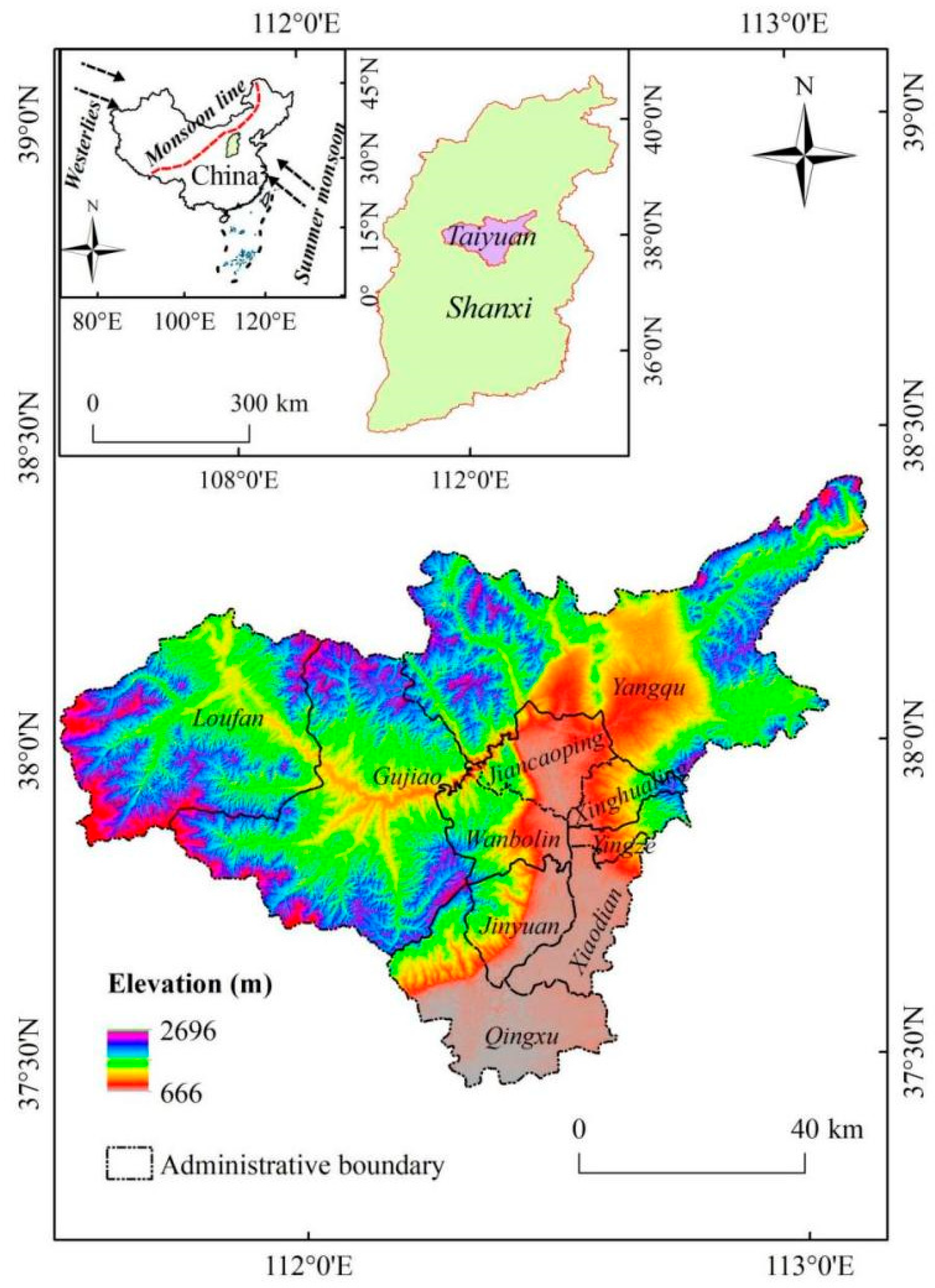

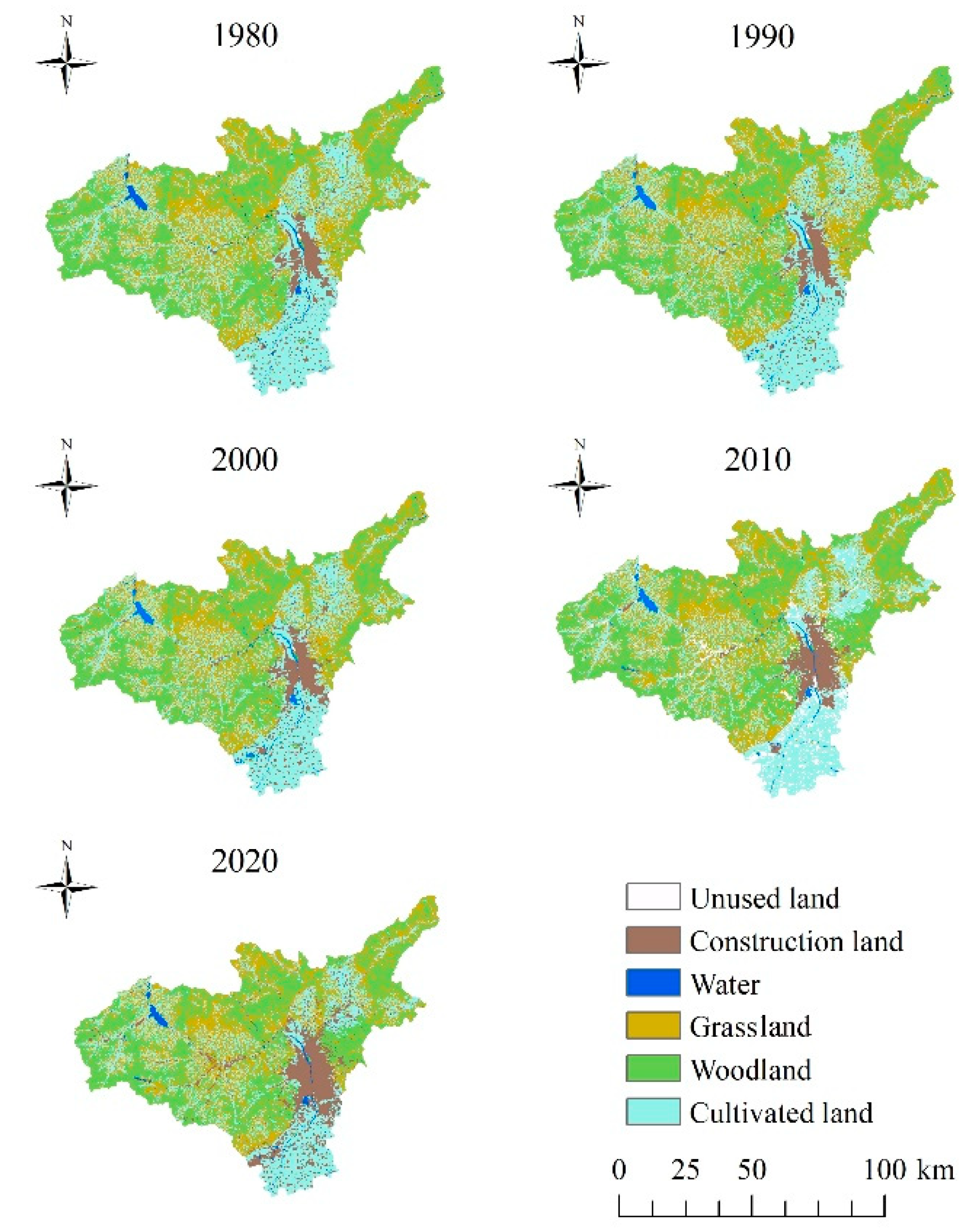
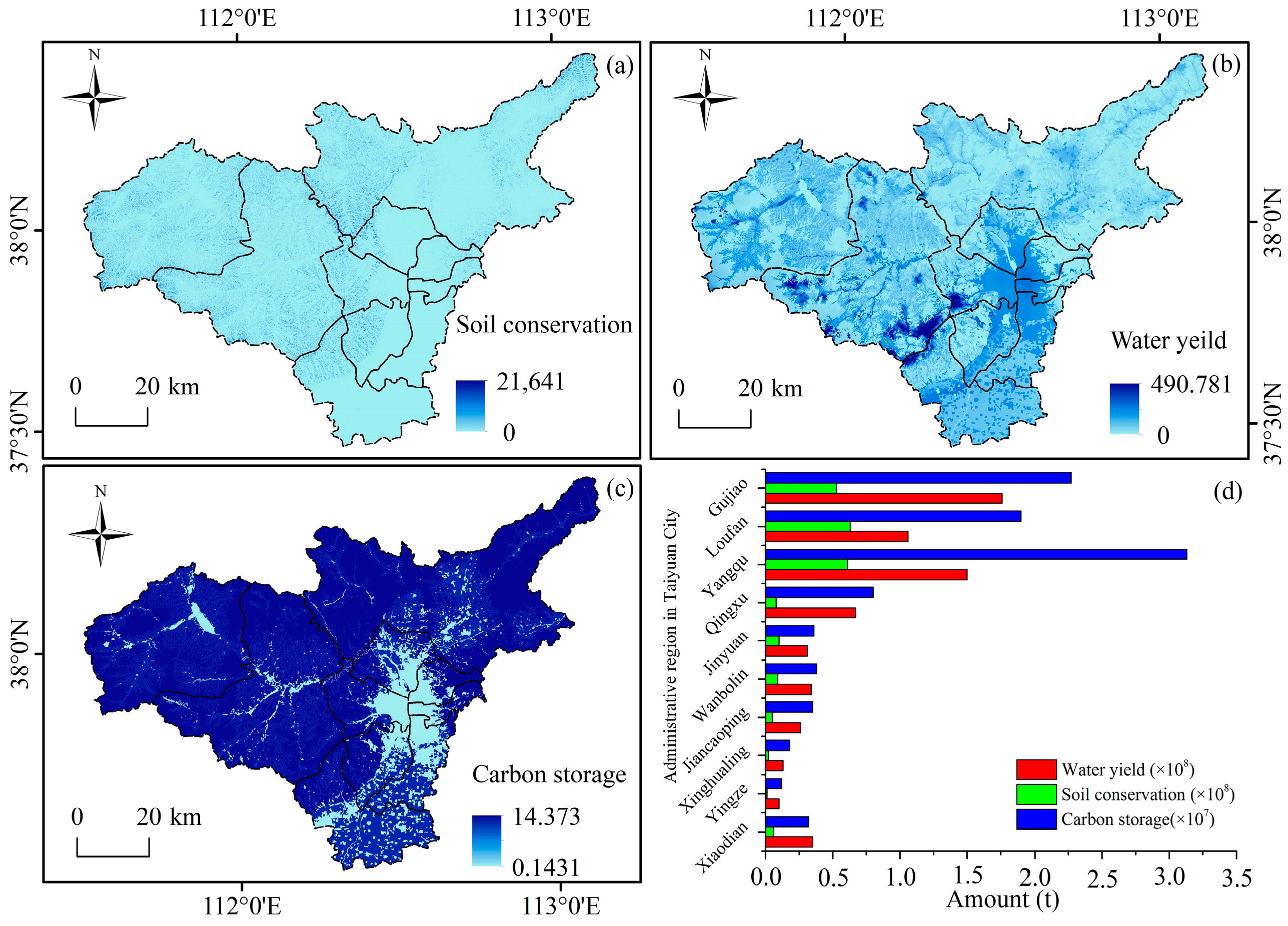


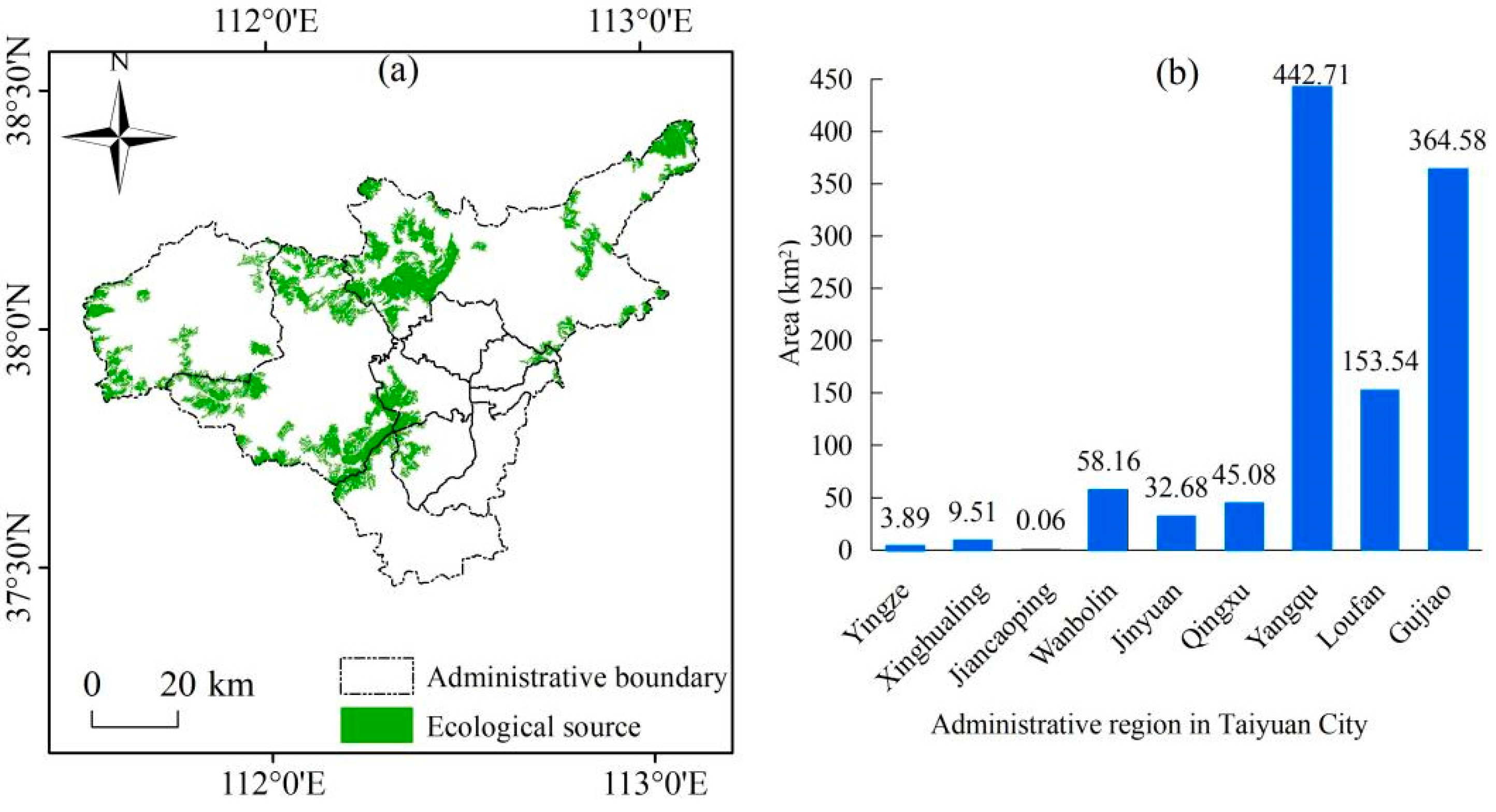
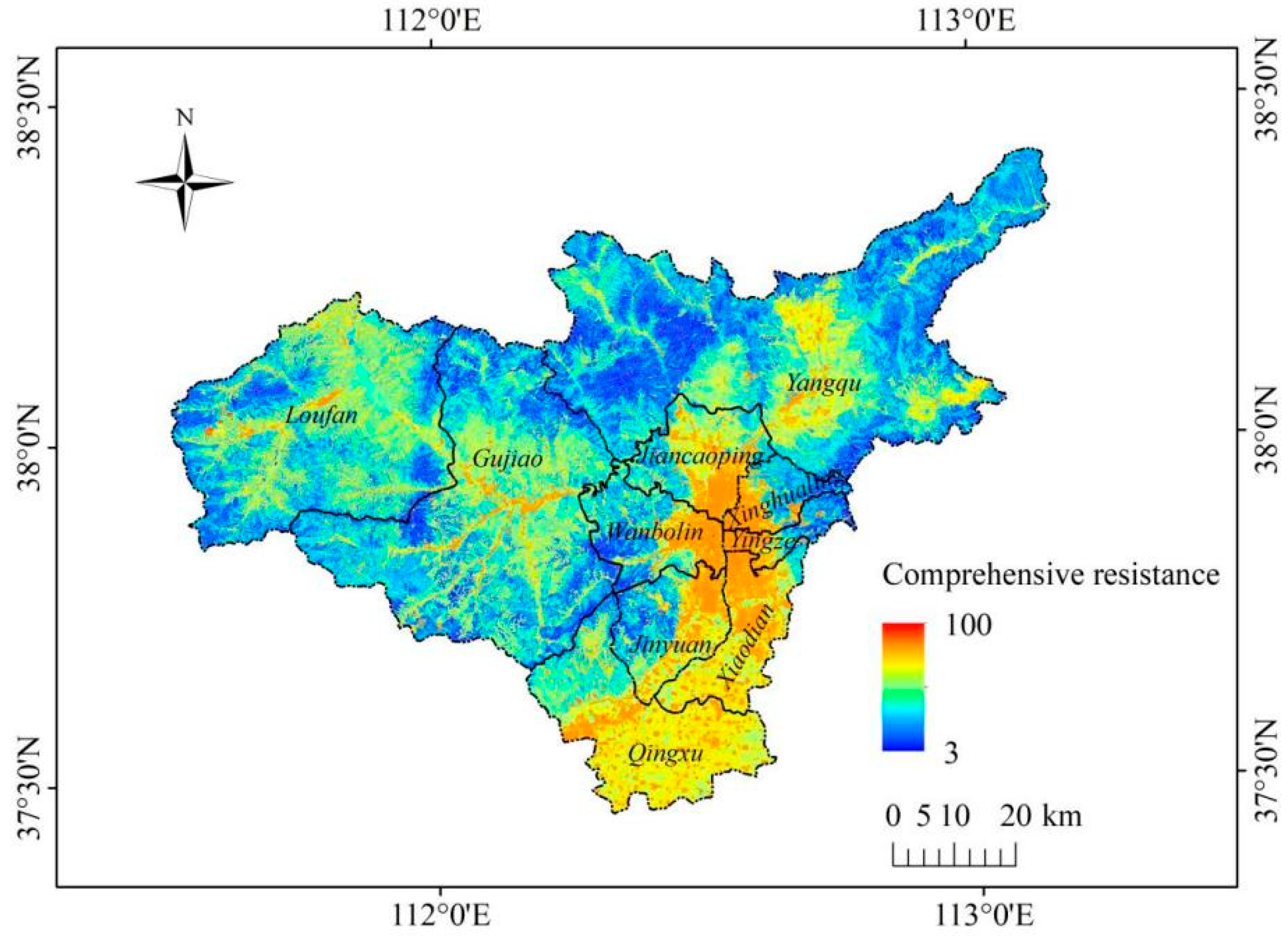


| Data Name | Spatial Resolution | Website Source |
|---|---|---|
| The administrative boundary | http://www.resdc.cn/ (accessed on 9 August 2021) | |
| Digital Elevation Model (DEM) | 30 m | http://www.gscloud.cn/ (accessed on 9 August 2021) |
| The LULC | 30 m | https://www.resdc.cn/DataSearch.aspx (accessed on 30 July 2021) |
| Precipitation | https://data.cma.cn/ (accessed on 10 August 2021) | |
| Soil thickness and Soil texture | 1000 m | http://www.iiasa.ac.at/Research/LUC/External-World-soil-database/HTML (accessed on 10 August 2021) |
| The potential evapotranspiration | 1000 m | http://www.cnern.org.cn (accessed on 9 August 2021) |
| Land Use Types | |||||||
|---|---|---|---|---|---|---|---|
| Cultivated Land | Woodland | Grassland | Water | Construction Land | Unused Land | ||
| 1980–1990 | Cultivated land | 2192.55 | 0.73 | 1.40 | 3.23 | 26.15 | 0.00 |
| Woodland | 0.94 | 2345.73 | 0.56 | 0.01 | 0.16 | 0.00 | |
| Grassland | 2.03 | 1.31 | 1911.09 | 0.02 | 3.42 | 0.21 | |
| Water | 0.04 | 0.01 | 0.11 | 76.18 | 0.00 | 0.00 | |
| Construction land | 0.18 | 0.01 | 0.03 | 0.00 | 306.28 | 0.00 | |
| Unused land | 0.00 | 0.00 | 0.00 | 0.00 | 0.00 | 2.61 | |
| 1990–2000 | Cultivated land | 2122.28 | 1.18 | 1.13 | 10.65 | 60.50 | 0.00 |
| Woodland | 5.94 | 2302.82 | 37.67 | 0.01 | 1.34 | 0.00 | |
| Grassland | 23.67 | 7.72 | 1877.55 | 0.24 | 4.00 | 0.00 | |
| Water | 1.81 | 0.00 | 0.10 | 77.09 | 0.43 | 0.00 | |
| Construction land | 0.19 | 0.01 | 0.03 | 0.01 | 335.69 | 0.00 | |
| Unused land | 0.00 | 0.00 | 0.00 | 0.00 | 0.00 | 2.82 | |
| 2000–2010 | Cultivated land | 1814.30 | 62.26 | 65.42 | 5.94 | 205.94 | 0.05 |
| Woodland | 17.05 | 2255.67 | 16.15 | 0.46 | 22.34 | 0.11 | |
| Grassland | 59.22 | 103.74 | 1694.14 | 0.55 | 58.04 | 0.78 | |
| Water | 8.28 | 0.37 | 0.49 | 64.50 | 14.35 | 0.00 | |
| Construction land | 25.77 | 3.97 | 2.33 | 1.38 | 368.50 | 0.00 | |
| Unused land | 0.64 | 0.01 | 0.02 | 0.03 | 1.38 | 0.75 | |
| 2010–2020 | Cultivated land | 1757.48 | 24.15 | 64.51 | 3.40 | 75.75 | 0.01 |
| Woodland | 28.65 | 2340.93 | 41.99 | 0.65 | 13.85 | 0.03 | |
| Grassland | 69.11 | 40.65 | 1658.10 | 0.93 | 9.77 | 0.09 | |
| Water | 2.11 | 0.51 | 1.01 | 67.96 | 1.27 | 0.00 | |
| Construction land | 21.85 | 4.10 | 5.48 | 1.41 | 637.78 | 0.03 | |
| Unused land | 0.01 | 0.03 | 0.08 | 0.00 | 0.13 | 1.44 | |
| Land Use | Single Land Use Dynamic Degree/% | ||||
|---|---|---|---|---|---|
| 1980–1990 | 1990–2000 | 2000–2010 | 2010–2020 | 1980–2020 | |
| Cultivated land | −0.13 | −0.19 | −1.19 | −0.25 | −0.40 |
| Woodland | 0.00 | −0.16 | 0.47 | −0.12 | 0.06 |
| Grassland | −0.03 | 0.02 | −0.77 | −0.04 | −0.20 |
| Water | 0.39 | 0.97 | −2.08 | 0.97 | 0.09 |
| Construction land | 0.88 | 1.64 | 4.01 | 1.04 | 3.65 |
| Unused land | 0.74 | 0.00 | −6.86 | −0.66 | −1.03 |
| Threat Factor | Maximum Distance/km | Weight | Attenuation Way |
|---|---|---|---|
| Cultivated land | 1 | 0.6 | Exponential |
| Road | 5 | 0.5 | Linearity |
| Urban land use | 7 | 0.8 | Exponential |
| Rural land use | 3 | 0.4 | Exponential |
| Industrial and mining land | 8 | 0.6 | Exponential |
| Resistance Factor | Scoring Standard | Resistance Value | Weight |
|---|---|---|---|
| NDVI/% | 0.2–0.4 | 80 | 0.2 |
| 0.4–0.6 | 50 | ||
| 0.6–0.8 | 30 | ||
| 0.8–1.0 | 1 | ||
| Slope/° | 0.0–2.0 | 10 | 0.15 |
| 2.0–6.0 | 30 | ||
| 6.0–15.0 | 50 | ||
| 15.0–25.0 | 80 | ||
| >25.0 | 100 | ||
| Habitat quality/% | 0.0–0.2 | 100 | 0.3 |
| 0.2–0.4 | 80 | ||
| 0.4–0.6 | 50 | ||
| 0.6–0.8 | 30 | ||
| 0.8–1.0 | 1 | ||
| Land use type | Woodland | 1 | 0.2 |
| Water | 20 | ||
| Grassland | 30 | ||
| Cultivated land | 50 | ||
| Construction land and unused land | 100 | ||
| Elevation/m | 677–950 | 10 | 0.15 |
| 950–1250 | 30 | ||
| 1250–1450 | 50 | ||
| 1450–1650 | 80 | ||
| 1650–2686 | 100 |
Disclaimer/Publisher’s Note: The statements, opinions and data contained in all publications are solely those of the individual author(s) and contributor(s) and not of MDPI and/or the editor(s). MDPI and/or the editor(s) disclaim responsibility for any injury to people or property resulting from any ideas, methods, instructions or products referred to in the content. |
© 2023 by the authors. Licensee MDPI, Basel, Switzerland. This article is an open access article distributed under the terms and conditions of the Creative Commons Attribution (CC BY) license (https://creativecommons.org/licenses/by/4.0/).
Share and Cite
Qiao, Q.; Zhen, Z.; Liu, L.; Luo, P. The Construction of Ecological Security Pattern under Rapid Urbanization in the Loess Plateau: A Case Study of Taiyuan City. Remote Sens. 2023, 15, 1523. https://doi.org/10.3390/rs15061523
Qiao Q, Zhen Z, Liu L, Luo P. The Construction of Ecological Security Pattern under Rapid Urbanization in the Loess Plateau: A Case Study of Taiyuan City. Remote Sensing. 2023; 15(6):1523. https://doi.org/10.3390/rs15061523
Chicago/Turabian StyleQiao, Qiong, Zhilei Zhen, Liming Liu, and Pingping Luo. 2023. "The Construction of Ecological Security Pattern under Rapid Urbanization in the Loess Plateau: A Case Study of Taiyuan City" Remote Sensing 15, no. 6: 1523. https://doi.org/10.3390/rs15061523






